Ski Gear Must-Haves: The Ultimate Guide to Essential Ski Equipment
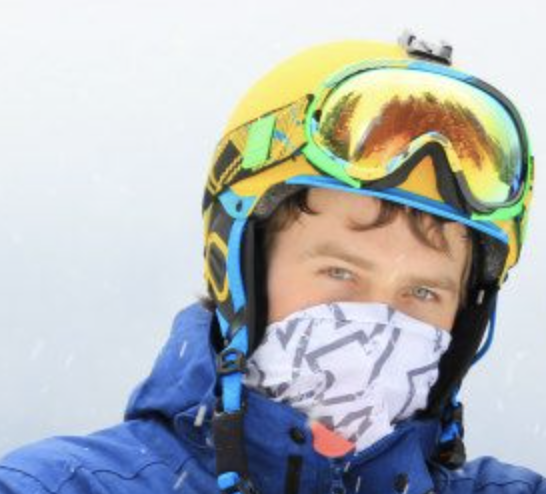
min read

min read
Skiing is more than just a winter sport; it’s an experience that combines adventure, skill, and the right ski gear must-haves. Whether you’re carving down well-groomed pistes, tackling fresh powder in the backcountry, or enjoying a casual day on the slopes, having the proper ski equipment is essential for comfort, safety, and performance. The right gear can make the difference between an unforgettable trip and one filled with discomfort, cold, or even injury.
From insulated clothing that keeps you warm and dry to high-performance skis and bindings that enhance control, every piece of equipment plays a crucial role. Many beginners make the mistake of underestimating the importance of proper layering or choosing ill-fitting ski boots, leading to unnecessary discomfort, reduced mobility, or even injuries. Experienced skiers, on the other hand, understand that high-quality accessories—such as a well-fitted helmet, moisture-wicking base layers, a durable ski backpack, and UV-protective sunglasses—can significantly improve their skiing experience.
Proper preparation starts with choosing the best ski gear must-haves for your skill level, climate conditions, and personal preferences. The right combination of ski clothing, safety gear, and essential accessories ensures that you stay warm, dry, and fully prepared for whatever the mountain throws at you.
In this comprehensive guide, we’ll cover every essential piece of ski gear must-haves, from base layers and salopettes to helmets, backpacks, and ski maintenance tools. Additionally, we’ll recommend top-rated products in each category, helping you make informed choices before hitting the slopes. Whether you’re a beginner preparing for your first trip or an experienced skier looking to upgrade your gear, this guide will ensure you’re fully equipped for an incredible skiing adventure. Here you can read about best kids ski gear.
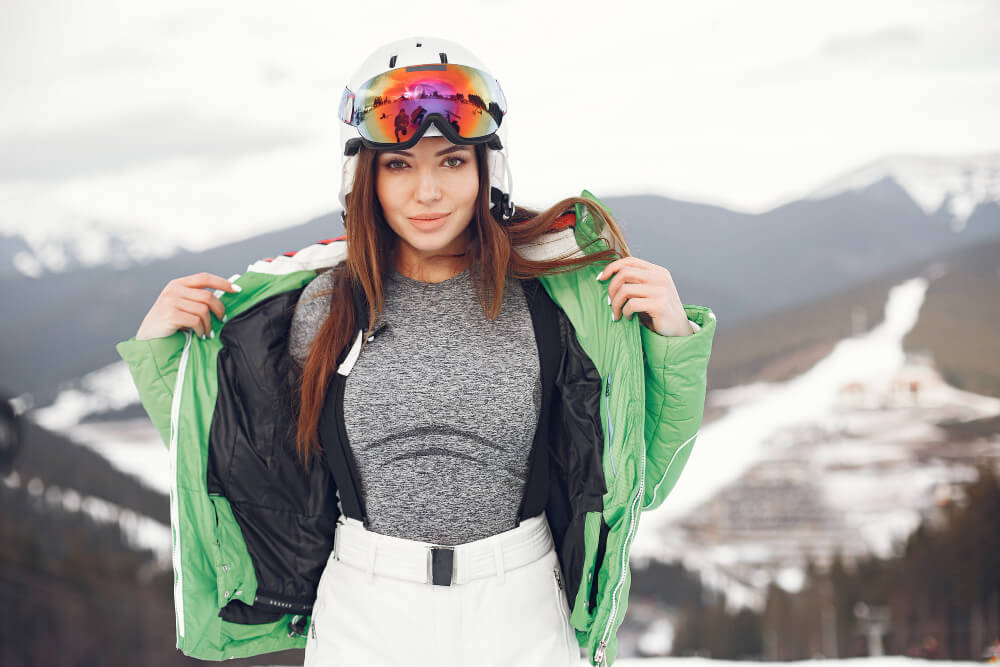
One of the most crucial aspects of skiing is dressing appropriately to stay warm, dry, and comfortable throughout the day. Skiing exposes you to harsh weather conditions, including freezing temperatures, strong winds, and heavy snowfall. Without the right clothing, even the most exciting ski adventure can quickly become uncomfortable—or worse, dangerous. The key to staying warm and dry on the slopes lies in layering your clothing properly, choosing the right materials, and ensuring each piece of gear serves a functional purpose.
The best way to dress for skiing is to use the three-layer system, which consists of:
Your base layer is the foundation of your ski outfit, and it plays a crucial role in temperature regulation. A good base layer will keep you warm without overheating, wick away sweat, and dry quickly.
Here you can find best deals on Amazon for ski base layers and ski underware.
Ski pants, also known as salopettes, are an essential part of your outerwear. They are designed to keep snow, wind, and moisture out while allowing full mobility.
Here you can find best deals on Amazon for ski pants.
A ski jacket is your primary shield against the elements, making it one of the most important pieces of ski clothing.
Here you can find best deals on Amazon for ski jackets. Over 6000 results for you to find your favorite one.
Your face and neck are particularly vulnerable to cold winds, snow, and frostbite, especially when skiing at high speeds. A neck gaiter or balaclava helps protect these areas.
Here you can find best deals on Amazon for neck warmers and balaclavas.
Never underestimate the importance of good ski socks. Cold feet can ruin a ski trip, and regular cotton socks just won’t cut it.
Here you can find best deals on Amazon for ski socks. Im sure you can find from their 7000 results something special and fitting for you.
Having the right ski clothing isn’t just about staying warm—it directly impacts your performance, endurance, and overall enjoyment on the slopes. Wearing moisture-wicking base layers prevents sweat buildup, an insulated mid-layer retains heat, and a high-quality waterproof outer layer shields you from the elements. Proper layering means you can regulate your body temperature easily, avoiding both overheating and getting too cold.
By investing in high-quality ski clothing, you’ll ski longer, more comfortably, and with greater confidence, knowing that your gear is keeping you warm, dry, and protected no matter the conditions.
By choosing the best ski clothing must-haves, you’ll ensure that your ski experience is warm, comfortable, and enjoyable, allowing you to focus on what truly matters—having fun on the slopes!
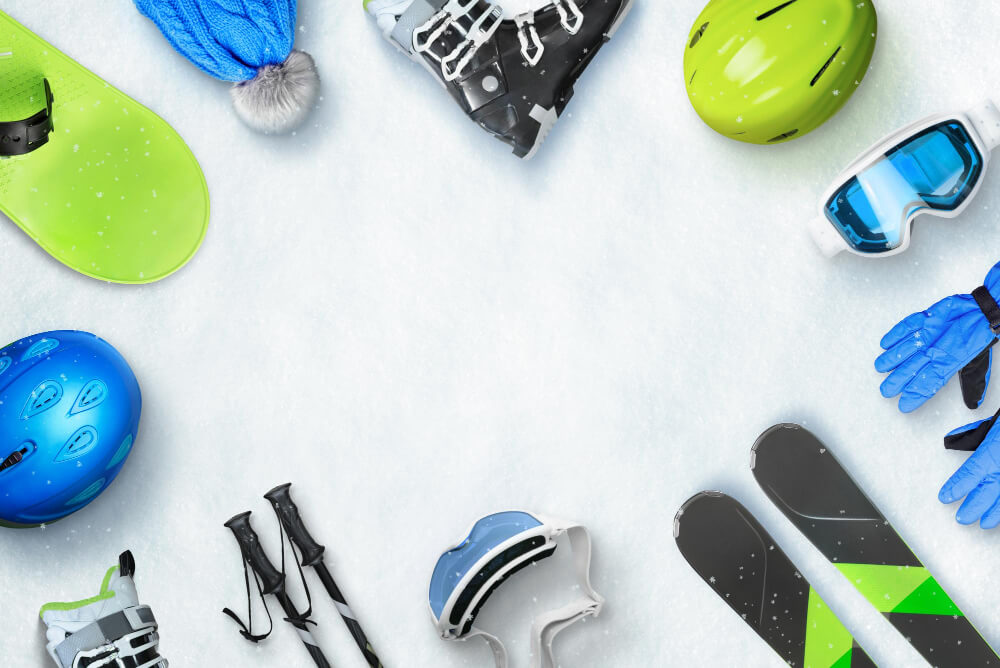
Skiing is an equipment-dependent sport, meaning that the quality and fit of your gear can significantly impact your performance, safety, and overall experience on the slopes. Unlike casual winter activities, skiing requires precise control, and the right equipment ensures that you can maneuver effectively, maintain balance, and maximize your enjoyment.
Choosing the right skis, boots, poles, and accessories is not just about personal preference—it depends on your skill level, terrain type, and skiing style. The right gear can enhance your speed, stability, and agility, while poor-quality or ill-fitting equipment can lead to fatigue, discomfort, and even injuries.
Let’s break down the essential pieces of ski equipment and how to select the best options for your needs.
Your skis and bindings form the core of your ski setup, dictating how well you move and control your speed on the slopes. The type of skis you choose should align with your experience level, preferred terrain, and skiing style.
All links from this section redriect you to evo.com e-shop. They have best variations of skis for every level of skier.
The length of your skis depends on your height, skill level, and skiing style:
Bindings connect your boots to your skis, and their settings must be adjusted based on your weight, height, skill level, and skiing style. Bindings should be professionally set to ensure proper release in case of a fall, preventing leg injuries.
✔ DIN Setting: Determines how easily your boot releases from the ski in case of a fall. Higher DIN settings are for aggressive, advanced skiers, while lower DIN settings are for beginners who need easier release.
✔ Brake Width: Should match the waist width of your skis to prevent dragging.
✔ Adjustability: Some bindings allow for micro-adjustments to accommodate different boot sizes.
If there’s one piece of ski gear that must fit perfectly, it’s your ski boots. A poor-fitting ski boot can cause pain, poor control, and even injury, whereas a well-fitted boot provides comfort, responsiveness, and precision.
✔ Flex Rating:
✔ Fit & Sizing:
✔ Liners & Customization:
Here you can find ski boots from evo.com.
Ski poles might seem like a minor part of your gear, but they play a vital role in balance, movement, and rhythm while skiing. They also help with steering, pushing on flat terrain, and navigating difficult slopes.
✔ Pole Length:
✔ Material:
✔ Basket Size:
Here you can find best deals on Amazon for ski poles. Over 2000 deals for you to choose from.
A ski-specific backpack is a game-changer, allowing you to carry essential gear such as water, snacks, extra layers, and safety equipment.
✔ Hydration Compatibility: Many ski backpacks come with hydration bladder sleeves to keep you hydrated without stopping.
✔ Avalanche Tool Storage: If skiing off-piste, look for a pack with dedicated compartments for a probe and shovel.
✔ Compression Straps & Fit: A snug fit prevents shifting and discomfort while skiing.
✔ Back Panel Access: Allows quick gear retrieval without taking the backpack off.
✔ Helmet Carry System: Some backpacks have clips or compartments for your helmet, making transport easier.
Here you can find best deals on Amazon for ski backpacks. Over 3000 deals for you to choose from.
Investing in a padded ski bag protects your skis, boots, and poles from damage during transport.
✔ Types of Ski Bags:
✔ Key Features:
Here you can find best deals on Amazon for ski bags. Over 6000 deals for you to choose from.
Having the right ski equipment must-haves can transform your skiing experience, providing better control, increased safety, and more enjoyment on the slopes. Properly selected skis, boots, poles, backpacks, and travel bags ensure that you’re comfortable and prepared for all conditions.
By investing in high-quality gear suited to your skill level and terrain, you can ski with confidence and ease, making every trip to the mountains an unforgettable adventure.
Next, I’ll cover ski safety gear in-depth, including helmets, goggles, and avalanche equipment!
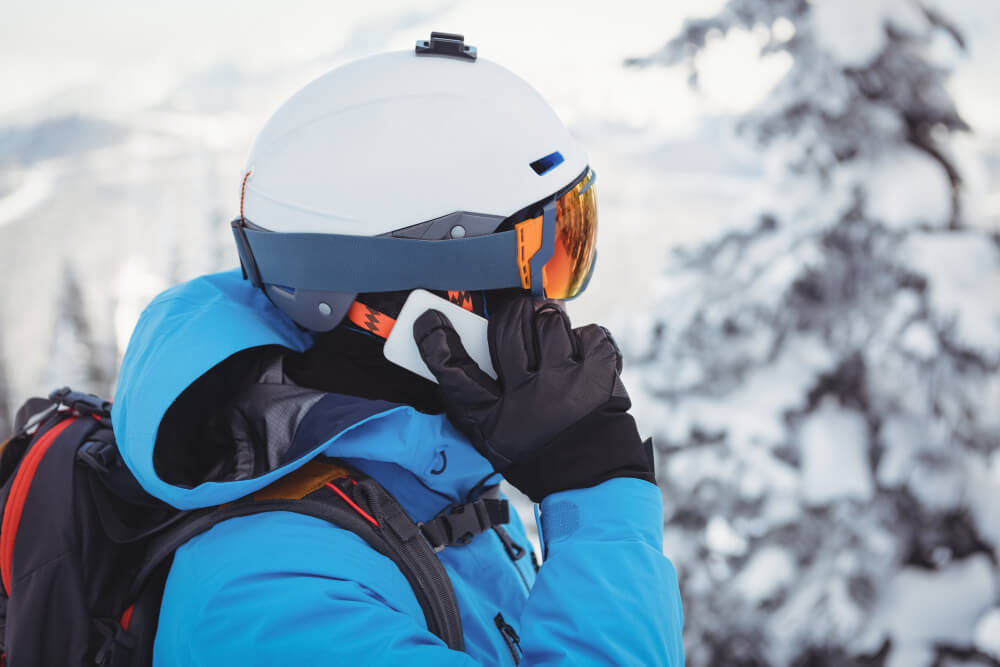
Skiing is an exhilarating and rewarding sport, but it also comes with inherent risks. From high-speed falls on groomed trails to unpredictable avalanches in the backcountry, having the right safety gear is non-negotiable. The proper protective equipment significantly reduces the risk of serious injuries and enhances visibility, awareness, and overall confidence on the slopes.
Many skiers—especially beginners—underestimate the importance of safety gear, assuming that ski resorts are controlled environments. However, collisions, poor visibility, and extreme weather conditions can all create hazardous situations. Investing in high-quality safety gear ensures that you’re well-protected, prepared for emergencies, and able to fully enjoy your time on the mountain.
Below, we’ll explore the must-have safety equipment, how to choose the right products, and why each piece of gear is essential for a safe and enjoyable skiing experience.
A high-quality ski helmet is the most important piece of safety gear. Skiing involves high speeds, unpredictable conditions, and the risk of collisions, making head protection absolutely necessary. Wearing a helmet can greatly reduce the severity of head injuries, keeping you safe in case of a fall or accident.
✔ MIPS Technology (Multi-directional Impact Protection System): Provides extra protection against rotational forces, reducing the risk of brain injuries.
✔ Ventilation System: Adjustable vents allow airflow regulation, preventing overheating and keeping your head cool during intense runs.
✔ Fit & Adjustability: A well-fitting helmet should be snug but comfortable, with an adjustable dial system for a customized fit.
✔ Compatibility with Goggles: Many helmets are designed to integrate seamlessly with ski goggles, preventing gaps that could expose your forehead to the cold.
✔ Lightweight Materials: Modern helmets use lightweight polycarbonate shells with EPS foam for maximum impact absorption without unnecessary weight.
💡 Did You Know? Studies show that wearing a ski helmet reduces head injury risk by up to 60%. Even low-speed falls can cause serious damage, so never hit the slopes without one.
Here you can find best deals on Amazon for ski helmets. Over 7000 deals for you to choose from.
A good pair of ski goggles is essential for clear vision, eye protection, and overall safety. Without them, snow glare, wind, and harsh weather can make it difficult to see properly, increasing the risk of accidents.
✔ UV Protection: The sun’s rays reflect off the snow, increasing exposure to harmful UV radiation. High-quality goggles block 100% of UVA and UVB rays, preventing eye damage.
✔ Anti-Fog Coating: Sudden temperature changes can cause goggles to fog up, severely reducing visibility. Look for double-layer lenses and anti-fog coatings to keep your vision clear.
✔ Lens Tint & Visibility:
✔ Helmet Compatibility: Ensure your goggles fit snugly with your helmet, leaving no gaps that could expose your skin to cold air and frostbite.
✔ Wide Field of Vision: Peripheral vision is crucial for safety, especially on busy slopes. Frameless and large-lens goggles provide a wider range of sight.
Here you can find best deals on Amazon for ski goggles. Over 3000 deals for you to choose from.
💡 Tip: Always carry a goggle wipe or microfiber cloth in your jacket pocket to remove ice and moisture from your lenses throughout the day.
While goggles are necessary for skiing, sunglasses are a must-have for off-slope activities such as walking around the resort, après-ski lounging, and sightseeing in bright conditions.
✔ Protection from Snow Blindness: UV exposure at high altitudes is stronger, and the reflection of the sun off the snow can cause temporary blindness.
✔ Wind & Debris Protection: Sunglasses shield your eyes from harsh winds, flying snow, and ice particles.
✔ Lightweight & Comfortable: Unlike goggles, sunglasses are easier to wear casually when not actively skiing.
✔ Polarized Lenses: Reduce glare and enhance contrast, improving depth perception in bright conditions.
✔ Wraparound Design: Protects against wind and side glare, ensuring full eye coverage.
✔ Impact-Resistant Frames: Lightweight polycarbonate frames prevent breakage in case of drops or impact.
✔ Anti-Slip Nose Pads: Keep the sunglasses secure and comfortable, even during active movement.
Here you can find best deals on Amazon for ski sunglasses. Over 2000 deals for you to choose from.
💡 Tip: If you’re skiing in warmer, spring conditions, you might prefer wearing sunglasses instead of goggles, especially if you’re on wide, sunny trails.
If you plan to ski in ungroomed, backcountry terrain, avalanche safety gear is absolutely essential. Avalanches are unpredictable, and having the right equipment can mean the difference between life and death.
✔ Avalanche Beacon (Transceiver): Sends and receives radio signals to help rescuers locate buried skiers.
✔ Avalanche Probe: A collapsible, lightweight pole used to pinpoint the exact location of a buried person.
✔ Shovel: Essential for digging out avalanche victims quickly. Look for a durable, lightweight aluminum model.
✔ Avalanche Airbag Backpack: Helps keep skiers afloat during an avalanche, reducing burial risk.
Here you can find best deals on Amazon for skiing safety gear. Over 1000 deals for you to choose from.
💡 Important: Even with the right equipment, proper avalanche safety training is crucial. Always check avalanche forecasts before venturing off-piste.
While a helmet provides warmth and protection on the slopes, a beanie hat is perfect for keeping your head warm before and after skiing.
✔ Thermal Insulation: Wool or fleece-lined beanies provide excellent warmth without overheating.
✔ Lightweight & Packable: A good beanie should easily fit in your jacket pocket or backpack.
✔ Breathability: Look for moisture-wicking materials to prevent sweat buildup.
Here you can find best deals on Amazon for skiing beanie hats. Over 20000 deals for you to choose from.
💡 Tip: If you’re taking a break from skiing or relaxing in an outdoor après-ski lounge, a beanie is a must-have to keep warm without the bulk of a helmet.
1️⃣ Smith Vantage MIPS Helmet – Lightweight, warm, and well-ventilated for all-day protection.
2️⃣ Oakley Flight Deck Goggles – Wide field of vision and anti-fog technology for maximum visibility.
3️⃣ Julbo Shield Sunglasses – High UV protection with side shields for optimal eye safety.
4️⃣ Black Diamond Recon BT Avalanche Beacon – A must-have for backcountry skiers.
5️⃣ The North Face Salty Dog Beanie – Stylish, warm, and perfect for après-ski relaxation.
Having the proper ski safety gear must-haves is not an option—it’s a necessity. A well-fitted helmet, clear-vision goggles, and avalanche safety tools provide peace of mind, confidence, and protection, allowing you to focus on enjoying the slopes without unnecessary risks.
By investing in high-quality safety gear, you’ll ski smarter, safer, and with greater confidence, knowing you’re fully protected in any situation.
Next up: Accessories & Extras—Small Items That Make a Big Difference!
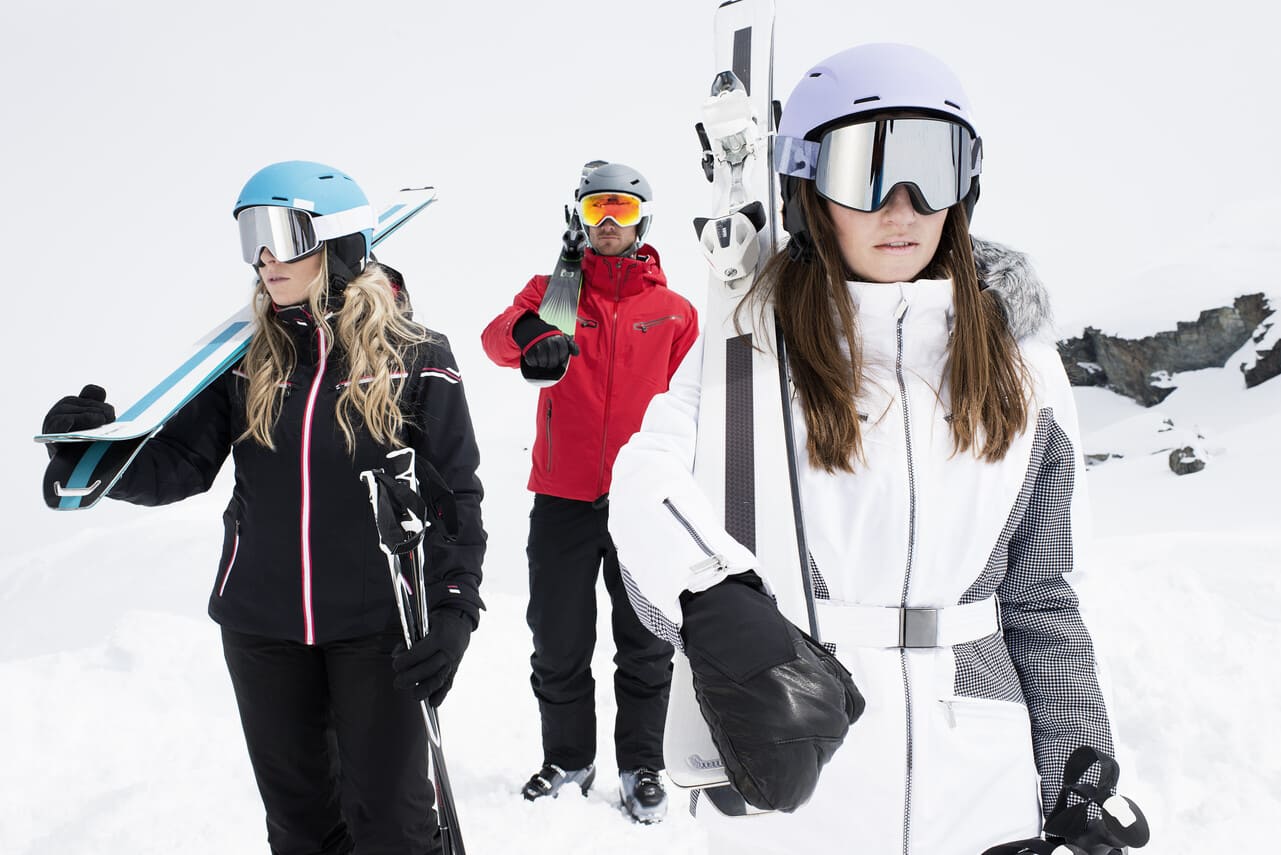
When preparing for a ski trip, most people focus on major gear like skis, boots, and jackets. However, the right accessories can greatly improve comfort, warmth, and convenience on the slopes. Whether it’s keeping your hands warm, protecting your face from windburn, or ensuring your boots are dry for the next day, these small but essential items can make a huge difference in your skiing experience.
Ski accessories are designed to enhance performance, increase comfort, and protect against extreme weather conditions. Many skiers, especially beginners, underestimate their importance, only to regret it when their fingers go numb in freezing temperatures or their goggles fog up halfway down the mountain. Properly selected gloves, hand warmers, neck protection, and hydration systems allow you to ski longer and more comfortably, no matter the conditions.
Below, we’ll dive into must-have ski accessories that can upgrade your experience on the slopes.
Cold hands can quickly ruin a ski day, making it difficult to grip your poles, adjust your bindings, or even use your phone. Investing in a high-quality pair of waterproof and insulated gloves is crucial.
✔ Waterproofing: Look for gloves made with GORE-TEX or similar waterproof membranes to keep your hands dry.
✔ Insulation Type:
✔ Gloves vs. Mittens:
✔ Touchscreen Compatibility: Some ski gloves come with touchscreen-sensitive fingertips, allowing you to use your phone without exposing your hands to the cold.
✔ Cuff Length:
Here you can find best deals on Amazon for ski gloves and mittens. Thousands of deals for you to choose from.
💡 Pro Tip: Carry a spare pair of lightweight gloves in your backpack in case your main gloves get wet or lost.
Even with insulated gloves and boots, extreme cold can still affect your fingers and toes, making skiing uncomfortable or even painful. Hand and toe warmers are a simple and effective solution.
✔ Disposable Warmers: Air-activated heat packs that provide 6–10 hours of warmth. Perfect for stuffing inside gloves, mittens, or ski boots.
✔ Reusable Warmers: Some brands offer rechargeable or gel-based warmers that can be reset by boiling in hot water.
✔ Best Placement for Warmers:
Here you can find best deals on Amazon for hand and toe warmers. Thousands of deals for you to choose from.
💡 Pro Tip: If you tend to get cold easily, place a hand warmer inside your ski jacket pocket to keep your core warm, which helps maintain overall body heat.
Your face and neck are constantly exposed to cold winds, snow, and UV rays, making a neck gaiter, balaclava, or facemask an essential ski accessory.
✔ Neck Gaiters (Buffs):
Here you can find best neck gaiters and buffs from Amazon.
✔ Balaclavas:
Here you can find best balaclavas from Amazon.
✔ Face Masks:
Here you can find best ski face masks from Amazon.
💡 Pro Tip: If you struggle with goggle fogging, choose a neck gaiter made with moisture-wicking fabric, and avoid covering your nose unless necessary.
Wearing damp ski boots the next morning is one of the worst ways to start a ski day. A ski boot dryer ensures your boots stay dry, warm, and odor-free.
✔ Removes Moisture: Prevents mold, bacteria, and foul odors from developing.
✔ Warms Boots Before Use: Nothing beats putting on warm ski boots in the morning, especially on freezing days.
✔ Extends Boot Lifespan: Dry boots last longer, as moisture can break down liner materials and stitching over time.
✔ Versatile Use: Can also be used for gloves, socks, and other wet gear.
Here you can find best ski boot dryers from Amazon.
💡 Pro Tip: If you don’t have a boot dryer, remove the liners from your ski boots at the end of the day and place them near a heater or vent to speed up drying.
Dehydration is one of the most overlooked problems in skiing. Cold weather suppresses thirst, making it easy to forget to drink water. A hydration pack ensures you stay hydrated without having to remove your gloves or stop skiing.
✔ Insulated Tube & Reservoir: Prevents the water from freezing in sub-zero temperatures.
✔ Ergonomic Design: Compact, lightweight, and comfortable for all-day wear.
✔ Water Capacity: Most hydration packs hold 1.5L–3L of water, enough for a full day on the slopes.
✔ Easy Access: A bite valve tube allows hands-free drinking, meaning you don’t need to stop skiing to take a sip.
Here you can find best ski hydration packs from Amazon.
💡 Pro Tip: Blow air back into the tube after drinking to prevent water from freezing inside the hose in extremely cold conditions.
1️⃣ Hestra Army Leather Heli Gloves – Durable, warm, and waterproof for extreme conditions.
2️⃣ HotHands Hand & Toe Warmers – Long-lasting heat packs for freezing temperatures.
3️⃣ Seirus Neofleece Face Mask – Windproof and breathable for full-face protection.
4️⃣ PEET Ski Boot Dryer – Eliminates moisture and keeps boots fresh.
5️⃣ CamelBak Zoid Hydration Pack – Compact and lightweight hydration system for skiing.
While ski accessories may seem like minor additions, they can greatly enhance your overall skiing experience. Whether it’s keeping your hands warm, staying hydrated, or preventing foggy goggles, these small but crucial items help you ski longer, more comfortably, and with less hassle.
By investing in the right accessories, you’ll ensure that every ski day is as smooth, warm, and enjoyable as possible—no matter how extreme the conditions are.
Next up: Ski Maintenance & Care—How to Keep Your Gear in Top Shape!
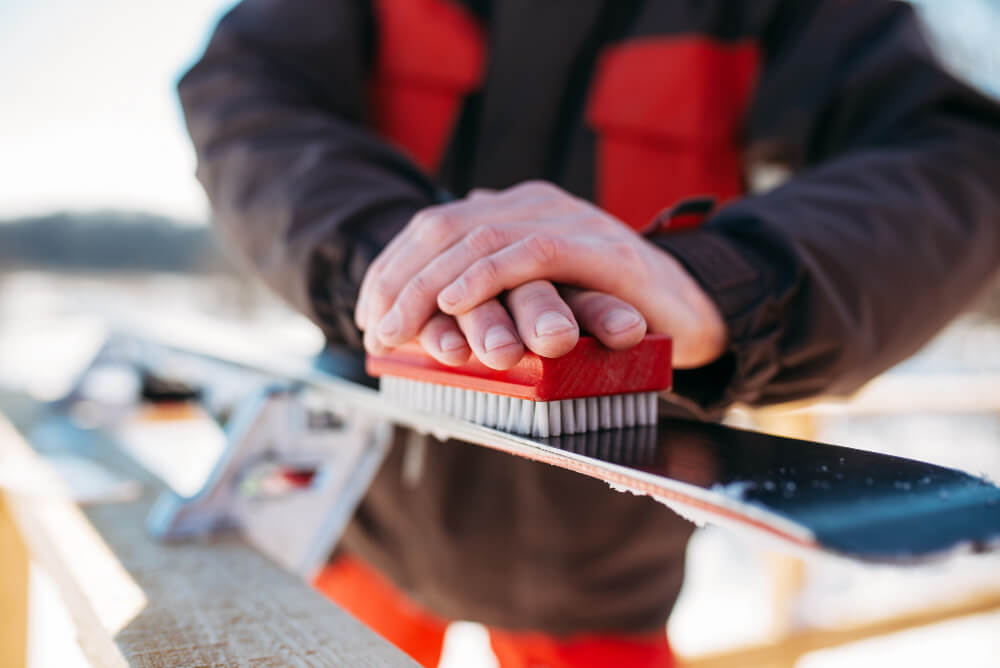
Skiing is an investment, and like any investment, proper maintenance is key to ensuring your gear lasts season after season. Neglecting maintenance can lead to decreased performance, reduced durability, and unnecessary expenses on repairs or replacements. Well-maintained skis glide more smoothly, boots remain comfortable and odor-free, and gear stays protected during transport and storage.
Whether you’re a casual skier or a dedicated enthusiast, understanding how to care for your ski equipment will improve your experience on the slopes and help you get the most out of your gear. Below, we cover essential maintenance tools and techniques to keep your skis, boots, and accessories in top condition.
Waxing your skis is essential for optimal glide, speed, and control on different snow conditions. Regular waxing reduces friction, keeping your skis smooth and preventing the dry, rough base feel that can slow you down.
✔ Frequent Skiers (Every Few Days on the Slopes) – Wax your skis every 3-5 ski days.
✔ Casual Skiers (Once or Twice a Season) – Wax your skis at the start and end of each season to maintain a healthy ski base.
✔ Backcountry Skiers – Frequent waxing is crucial as natural snow is more abrasive than groomed runs.
Here you can find best ski waxes from Amazon.
💡 Pro Tip: If you don’t want to wax your skis yourself, most ski shops offer professional waxing services. However, learning how to do it yourself can save money and improve performance by tailoring your wax to specific conditions.
Keeping your ski edges sharp is essential for maintaining grip, control, and turning precision, especially on icy runs. Dull edges lead to poor carving ability and reduced stability on hard-packed snow.
✔ Skis Slip on Ice – If you’re struggling to hold an edge on icy slopes, it’s time to sharpen them.
✔ Edges Feel Rough or Have Burrs – Run your finger along the edge—if you feel rough spots or nicks, sharpening is necessary.
✔ Decreased Turning Performance – Dull edges make it harder to initiate turns, requiring more effort to control your skis.
✔ Casual Skiers – Sharpen once or twice per season.
✔ Frequent Skiers – Sharpen every 5-7 days on the mountain.
✔ Racers & Advanced Skiers – Sharpen before every major trip or competition.
Here you can find best deals on ski edge sharpeners from Amazon.
💡 Pro Tip: If you’re skiing in softer, powdery conditions, you don’t need razor-sharp edges—dulling the edges slightly can actually improve performance.
Ski equipment is expensive, and improper storage or transport can cause damage that affects performance. Investing in high-quality storage and travel bags ensures that your gear stays protected during off-season storage and transportation.
✔ Padded Ski Bags – Provide extra protection when traveling by car, train, or plane.
✔ Wheeled Ski Bags – Ideal for long-distance travel, making it easier to transport heavy gear.
✔ Hard-Shell Cases – Offer maximum protection for air travel and rough handling.
✔ Boot Bags with Ventilation – Prevent boots from getting musty or developing odors after a ski trip.
Here you can find best deals on ski travel bags from Amazon.
💡 Pro Tip: Before storing your skis for the off-season, apply a layer of wax but don’t scrape it off. This protects the base from drying out and prevents rust on the edges.
Ski boots and gloves often trap moisture, which can lead to discomfort, bad odors, and even mold growth. A boot and glove dryer helps eliminate moisture overnight, ensuring that your gear is dry, warm, and ready to go the next morning.
✔ Prevents Mold & Bacteria Growth – Damp boots create the perfect environment for bacteria, leading to unpleasant smells.
✔ Extends Lifespan of Boots & Gloves – Drying gear properly prevents material breakdown and keeps the insulation working efficiently.
✔ Warmer Gear = More Comfort – Putting on dry, warm boots in the morning makes a huge difference in comfort, especially on cold days.
💡 Pro Tip: If you don’t have a dedicated dryer, remove your boot liners and place them near a heater or fan to help them dry overnight.
At the end of a ski day, snow and ice can build up on your skis, boots, and bindings. Using a snow brush and scraper prevents ice buildup, ensuring that your gear is clean and ready for storage.
✔ Prevents Ice Formation: Removing snow from bindings prevents frozen mechanisms, which can affect ski release and boot fit.
✔ Keeps Skis & Boots Clean: Ice buildup can cause unnecessary wear on boot buckles, bindings, and ski bases.
✔ Improves Gear Longevity: Regular cleaning prevents moisture from seeping into gear, extending its lifespan.
💡 Pro Tip: Use a soft-bristle snow brush to remove excess snow from goggles and jackets, preventing fogging and water absorption.
1️⃣ Swix Universal Ski Wax Kit – Essential for keeping your skis in top shape.
2️⃣ Dakine Edge Tuner Tool – Keeps your ski edges sharp for icy conditions.
3️⃣ Thule RoundTrip Ski Roller Bag – Provides excellent protection for travel.
4️⃣ DryGuy Force Dry DX Boot Dryer – Dries boots efficiently, preventing odor buildup.
5️⃣ Demon Hyper Snowboard & Ski Tune Kit – A complete kit for waxing, tuning, and maintaining your gear.
Taking care of your ski gear is just as important as choosing the right equipment. A well-waxed ski base, sharp edges, and dry boots make skiing more enjoyable and efficient while reducing wear and tear on your equipment.
By investing in regular maintenance and high-quality storage solutions, you’ll extend the lifespan of your gear, saving money in the long run and ensuring that every ski day is smooth, fast, and comfortable.
Next up: Conclusion—Bringing It All Together!
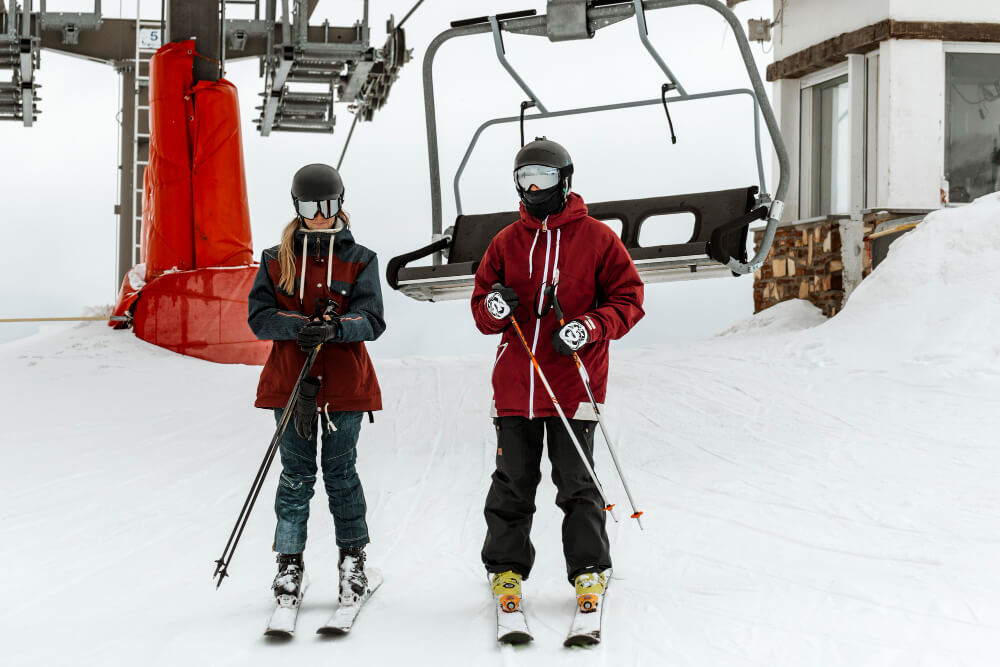
Having the right ski gear must-haves is not just about comfort and performance—it’s about safety, longevity, and maximizing your enjoyment on the slopes. Whether you’re skiing on groomed runs, deep powder, or backcountry terrain, the right equipment ensures that you stay warm, dry, and well-protected in all conditions.
From layered clothing that regulates body temperature to well-fitted boots that provide maximum control, every piece of gear plays a role in enhancing your experience. Safety equipment like helmets and goggles protect against injuries, while accessories like hand warmers, ski boot dryers, and hydration packs add extra convenience and comfort. Regular maintenance and proper storage ensure that your ski gear remains in top condition year after year.
Skiing is an incredible sport that combines thrill, adventure, and skill, but your experience is only as good as the gear you bring with you. Investing in high-quality ski clothing, safety gear, and essential accessories will allow you to ski longer, with more confidence, and in total comfort. Whether you’re a first-time skier gearing up for your debut trip or a seasoned expert fine-tuning your equipment, having the best ski gear ensures every ski day is an unforgettable one.
So, the real question is—are you ready to hit the slopes fully prepared for your next ski adventure?